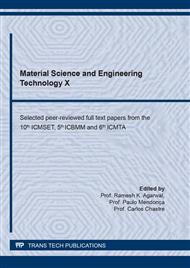p.131
p.137
p.143
p.148
p.157
p.165
p.170
p.176
p.185
Thermally Conductive Cellulose/Coper Composite Rods for Tailoring the Characteristics of Cigarettes
Abstract:
A new style of low temperature combustion cigarettes was prepared by implanting a thermally conductive cellulose/coper composite rod (TCCR) in the cut tobacco section, so as to explore the application feasibility at the low temperature environment. The burning temperature of the cigarettes was investigated by thermocouple to study the influence of the implanted TCCRs. The emission of conventional components and seven harmful components in mainstream smoke were also carried out to study the effect of TCCRs. The results show that implantation of TCCRs could reduce the burning temperature of cigarettes effectively, which decreased over 100 °C. In compared with conventional cigarettes, the amount of nicotine and nicotine-freed dry particulate matter (NFDPM) in mainstream smoke of TCCRs implanted cigarettes changed little, while the release of harmful components such as CO, HCN, NNK and phenol decreased over 20%. Moreover, the TCCRs, which made of copper paper with 2 g / 18 g weight ratio of pulp and copper, and 5 mm interval perforating, could reduce the burning temperature of cigarettes by 145 °C and the hazard index by 2.01.
Info:
Periodical:
Pages:
157-164
Citation:
Online since:
February 2022
Authors:
Price:
Сopyright:
© 2022 Trans Tech Publications Ltd. All Rights Reserved
Share:
Citation:


